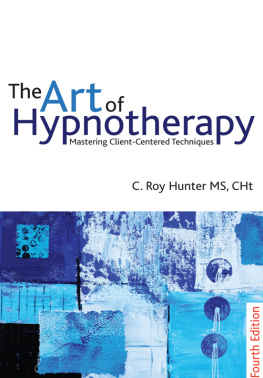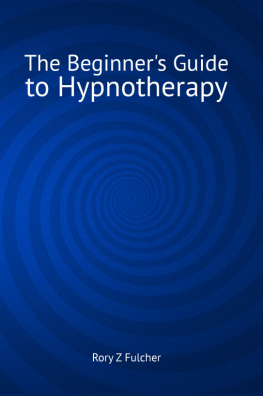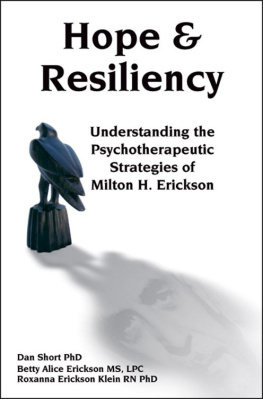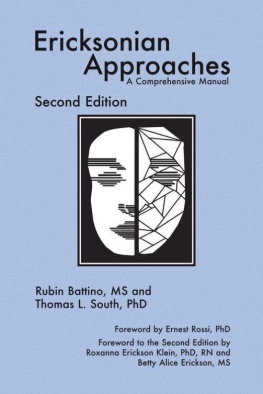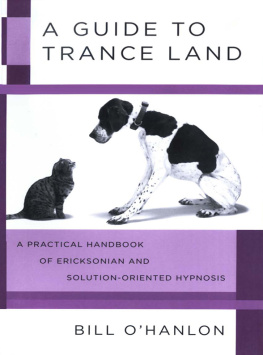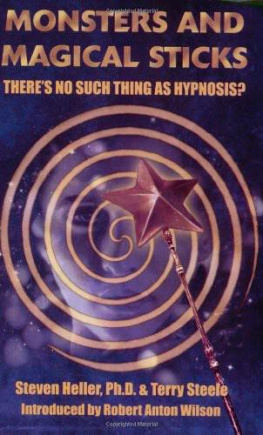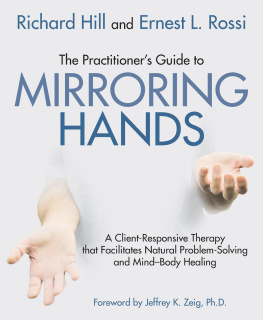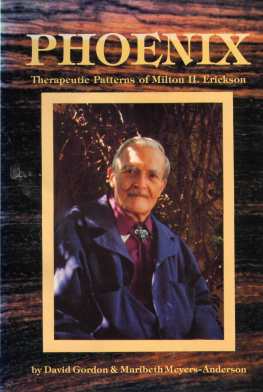Speak
Ericksonian
Mastering THE
HYPNOTIC METHODS OF
MILTON ERICKSON
____________
Dr. Richard K. Nongard
and James Hazlerig, M.A.
Speak Ericksonian
Mastering the Hypnotic Methods of Milton Erickson
Dr. Richard K. Nongard
and James Hazlerig, M.A.
Cover graphics by Dustin Tilley-Sturgeon
Copyright 2014 by Dr. Richard K. Nongard, All Rights Reserved.
No part of this publication may be reproduced, stored in a retrieval system or transmitted in any form or by any meanselectronic, mechanical, photocopy, recording or any otherwithout the prior written permission of the publisher. The only exception is brief quotations in printed reviews or scholarly journals.
First Printing: June 2014
PeachTree Professional Education, Inc.
7107 S. Yale, Ste 370
Tulsa, OK 74136
(918) 236-6116
www.SubliminalScience.com
About the Authors
Dr. Richard K. Nongard is among the most qualified hypnotherapists in the Southwest, and has authored many books, videos and professional educational materials, including hypnotherapy textbooks. He holds advanced degrees on both Religion and Counseling, and has been trained in the USA, Canada and Europe.
Dr. Nongard has completed his doctorate in transformational leadership with a concentration in cultural transformation through Bakke Graduate University. BGU is a nationally accredited university, accredited by an accreditor which is recognized by both the United States Department of Education (USDOE) and the Council for Higher Education Accreditation (CHEA). He holds a Masters degree in Counseling from Liberty University.
His contributions in Eriskonian approaches to hypnotherapy, Contextual Hypnotherapy and other solution focused approaches have been recognized by organizations in both mental health and hypnotherapy communities.
James Hazlerig, MA , is a master storyteller and certified hypnosis practitioner with a private practice in Austin, Texas. He holds an accredited Masters Degree in English from Stephen F. Austin State University. His training in Ericksonian hypnosis began with Kathy Moore, MBA, of the San Antonio Wellness Center and has continued with various instructors and authors. He is a graduate of the Hypnosis Practitioner Training Institute, where he now teaches a course in hypnosis history. Hazlerig applies the principles of Ericksonian hypnosis in the Mental Freedom classes he teaches to inmates and recovering drug addicts in Travis County, Texas.
Editorial Note: This book began its life as a series of lectures delivered by Dr. Nongard; the second authors role was primarily to organize and collate Dr. Nongards wisdom into its current form. For claritys sake, the I in this text is Dr. Nongards voice. During the lectures, he occasionally credited his colleague James Hazlerig with certain ideas, referring to the second author in the third person. We have maintained that conceit throughout the text, even for passages contributed by the second author.
Table of Contents
Introduction to
Ericksonian Hypnotherapy
The Secret of
Ericksonian Induction
The Multiple-Dissociation
Induction
The Hand Levitation
Induction
A Few Words about
Covert Hypnosis
Metaphor, Parable,
and Story
Modalities and
Submodalities
Neuro-Linguistic
Programming Ideas
Based on Erickson
Final Words and
Further Reading
The Reverse Arm Levitation
Induction
Two Sample
Healing Hypnosis Sessions
Prairie Dogs
by Dave Parke
Getting
Started
Chapter One
Introduction to
Ericksonian Hypnotherapy
Who was Milton Erickson?
He was, of course, a psychiatrist who specialized in treating medical conditions utilizing medical hypnosis, and he was also known for his work in family therapy. Unlike earlier thinkers, who viewed the unconscious mind as a dark place filled with mysterious neuroses and crippling complexes, Erickson saw the unconscious mind as being infinitely intelligent, a reservoir of solutions and creativity.
Many of Milton Ericksons ideas about the power of the mind actually came out of his own experiences, having survived polio at age seventeen. The Milton Erickson Foundation website has this to say on the topic:
At age 17, [Milton Erickson] contracted polio and was so severely paralyzed that doctors believed he would die. While recovering in bed, almost entirely lame and unable to speak, he became strongly aware of the significance of nonverbal communicationbody language, tone of voice, and the way that these nonverbal expressions often directly contradicted the verbal ones. He also began to have body memories of the muscular activity of his own body. By concentrating on these memories, he slowly began to regain control of parts of his body to the point where he was eventually able to talk and use his arms again. His doctor recommended exercising his upper body only, so Milton Erickson planned a 1,000 miles canoe trip to build up the strength to attend college. His adventure was challenging, and although he still did not have the full use of his legs at the end, he was able to walk with a cane.
Without a doubt, his own personal experiences in using the power of his mind to recover from the tragic medical condition of polio certainly became an experiential base of knowledge for him to develop the techniques of solid clinical hypnotherapy to help a wide variety of medical clients.
The Influence of Milton Erickson
As perhaps the most widely studied hypnotist in the world, Ericksons influence extends far beyond medical hypnosis and family therapy. We can see his influence, particularly in language structure, in the cadence of hypnotherapy, and in the physical proximity of therapist to client, in almost every approach to hypnosis, Neuro-Linguistic Programming (NLP), and contextual psychology.
In fact, even in Regression Hypnotherapy, which is a definitely non-Ericksonian school of thought, many practitioners nonetheless use the language patterns or the techniques of Milton Erickson. Almost everybody who practices hypnosis todayand I would include stage hypnotists in this, even though Erickson opposed stage hypnosishave been profoundly influenced by Milton Ericksons work.
The Ericksonian Approach
To really understand Ericksonian hypnotic techniques, its important to put his approach in context by contrasting it to other hypnotic approaches. Broadly speaking, there are three primary approaches to hypnosis.
The first is the Authoritarian Approach, which is predicated on the hypnotist doing something to somebody. For example, most stage hypnosis (and most hypnosis portrayed in fiction) presents the illusion of the all-powerful Svengali character controlling another persons will. In truth, thats more theatre or drama or social compliance than anything else. Up until Milton Ericksons time, many hypnotists used primarily an Authoritarian Approach. They might have not been abusive about it, but they simply told the person what to do: And now, I will count backwards from one to three, and when I do, you will go into trance: Oneclose your eyes. Tworelax further. Threedrift deep into trance. That is really an Authoritarian Approach: The hypnotist tells somebody what they will do, expecting that response. The Authoritarian Approach sometimes relies on the presupposition that there is something special, almost magical, about the hypnotist that allows him to dominate the will of others.
Whereas the Authoritarian Approach is predicated on the hypnotist doing something to someone, the Standardized Approach is predicated on whether or not the subject is suggestible. The Standardized Approach was developed in the early twentieth century by researchers who were trying to determine how suggestible their research subjects were. In order to eliminate variables that could skew results, inductions and hypnotic language were standardized; indeed, they were often recorded or read verbatim, usually in a monotone by an untrained graduate student reading in a monotone. Even though the Standardized Approach was never meant for therapy, a number of practitioners have tried to apply it in the office, even turning away clients who did not respond to a standardized induction and suggestions. The Standardized Approach, while important for research, has led to the misconception that only some people can benefit from hypnosis, as it is predicated on the subject responding to certain standardized language.


